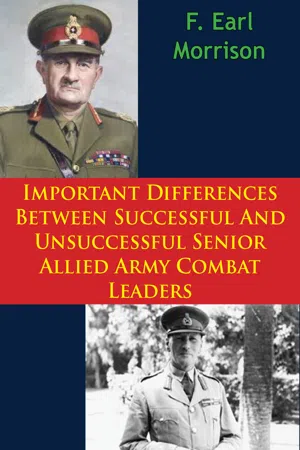![]()
SOME SUCCESSFUL AND UNSUCCESSFUL SENIOR COMBAT LEADERS
It would be an immense task to study all the senior Allied Army combat leaders in World War II. However, some differences in qualities and abilities of successful and unsuccessful senior combat leaders might be discernible from studying two from each category. But which four? Military historians at the U.S. Army War College suggested that available materials might allow discerning some differences between successful and unsuccessful leaders and that this might be achieved by studying available materials on General Robert L. Eichelberger and Field Marshal Sir William Slim as examples of successful senior combat leaders. They suggested Generals Sir Claude Auchinleck and Arthur Percival as examples of unsuccessful senior combat leaders.
Eichelberger—MacArthur’s Fireman
Robert L. Eichelberger graduated 68th out of 103 graduates in West Point’s class of 1909. As a Second Lieutenant on his regiment’s annual 200-mile practice road march, he wore new shoes. With blistered and sore feet, he limped the last 100 miles of the march, refusing to ride in the accompanying ambulance. He believed that to set the example by accepting hardship with the troops, working hard, and being self-disciplined, he would earn their respect and increase morale and efficiency. Later, in the Panamanian jungle, he learned that training must be tough and realistic and that soldiers must be pushed to their real limits, which are greater than they think. Caring not only for success but for the troops required this. With the U. S. expedition to Siberia during World War I, he evidenced courage and determination. On one occasion, at danger to his life, he entered partisan lines and effected the release of one American officer and three enlisted men in exchange for one Russian prisoner. On another occasion, when an American patrol had seriously wounded men, armed with a rifle he covered the platoon’s withdrawal. On yet another occasion, when an American column received fire while marching down from a mountain, disregarding his own safety he voluntarily assisted in establishing a firing line and preventing confusion. This raised the morale of the troops to a high pitch.{3}
In August 1942, Lieutenant General Eichelberger departed for Australia to serve under General Douglas MacArthur. In three major campaigns luring World War II, MacArthur suffered initial setbacks from the Japanese—Buna in December 1942, Biak in June 1944, and Manila in January 1945. Each time he called in a fireman, or rescuer, General Eichelberger, to rally the American troops and salvage desperate tactical situations. Each time Eichelberger’s combination of personal leadership, commonsense training, and tactical innovation achieved a dramatic result.{4} Two of these campaigns—Buna and Biak—offer several examples which demonstrate that Eichelberger had the qualities and abilities important to successful senior combat leadership.
Buna was MacArthur’s first offensive of the war. The attack began on 16 November 1942. The insufficiently trained American division was stymied by the Japanese, however. In the first two weeks of the campaign it had not once penetrated the Japanese positions. Its poor performance was causing the Australians to question the fighting abilities of American soldiers. MacArthur was alarmed. He called Eichelberger in from Australia and on the evening of 30 November 1942 gave him the following verbal orders.
“Bob, I’m putting you in command at Buna. Relieve Harding. I am sending you in, Bob, and I want you to remove all officers who won’t fight. Relieve Regimental and Battalion commanders; if necessary, put Sergeants in charge of Battalions and Corporals in charge of companies—anyone who will fight. Time is of the essence; the Japs may land reinforcements any night.... I want you to take Buna or not come back alive.”{5}
When Eichelberger arrived at Buna, he found skeletal-looking starving men at the front. They were dirty, had no sanitation system, and were scrambled like eggs rather than being together in their units. There was no effective chain of command. The men were also tired, demoralized, and not fighting aggressively. Eichelberger relieved General Harding and replaced the regimental commanders and the supply officer. He halted fighting for two days, during which he got the troops cleaned and back in their units with a clear chain of command. He gave them their first hot meal in ten days. On 5 December 1942, Eichelberger attacked the Japanese on two fronts. He, his subordinate commanders, and his most trusted staff showed courage by leading the battle at the fronts to rally the troops and show them what was expected. The left front, led by Eichelberger, pierced a wedge to the sea between Buna Mission and Buna Village giving the Division its first victory in combat and raising the soldiers’ confidence in themselves. Throughout the next month, Eichelberger showed determination and strength of will by continuing to attack the Japanese until on 2 January 1943 Buna was conquered...
